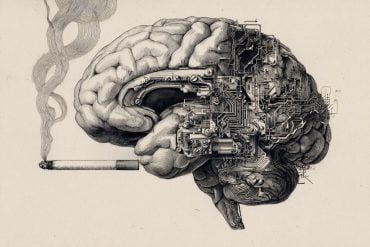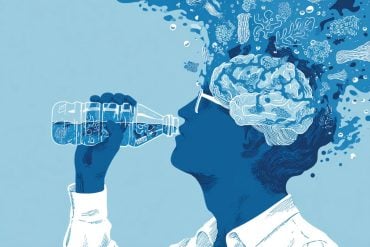Summary: In babies born preterm, the cerebral cortex, a brain area associated with learning and cognition is often underdeveloped. In preterm babies fed larger quantities of breastmilk, the cerebral cortex resembled those of babies born full term. Researchers say breastfeeding could help to reduce learning and behavioral deficits associated with preterm birth.
Source: University of Edinburgh
The more breast milk premature babies are fed while in neonatal intensive care, the greater the level of brain development, a study suggests.
The cerebral cortex—the part of the brain for learning and thinking—is usually underdeveloped in premature babies, but in infants who consumed high levels of breast milk it quickly resembled those of babies born to term.
Experts say that feeding premature babies with breast milk could help reduce the developmental and learning problems associated with preterm birth.
Every year, 15 million children worldwide are born pre-term—before 37 weeks—and it is still the biggest cause of death and disability among newborn babies.
Children who are born early are more likely to develop problems that affect their entire lives such as learning difficulties, problems with their sight and hearing, behavioral issues and cerebral palsy.
Researchers from University scanned the brains of 212 babies who were part of the Theirworld Edinburgh Birth Cohort, a study which monitors the progress of premature babies from birth to adulthood.
The group included 135 babies who were born before 32 weeks of pregnancy and 77 who were born to term. Researchers collected information about how premature babies were fed during neonatal intensive care and brain scans for all babies were performed around 40 weeks from conception.
Brain scans revealed that babies who received higher amounts of breast milk—from their mother or a donor—had a more mature cerebral cortex compared with those who received less, similar to the scans of babies born to term.
Supporting development
Breast milk contains many elements—such as a favorable balance of fats, proteins and minerals, and a range of other beneficial factors that help babies’ immunity—that could support brain development, experts say.
Further research is needed to understand their exact role in allowing premature babies’ brains to catch up with the development seen in term babies.

“Our findings suggest that brain development in the weeks after preterm birth is improved in babies who receive greater amounts of breast milk. Mothers of preterm babies should be supported to express breast milk, if they are able to, while their baby is in the neonatal unit as this may offer the best chance of healthy brain development,” says Dr. Gemma Sullivan.
The Jennifer Brown Research Laboratory was set up in 2004 at the University of Edinburgh as a pioneering project of Theirworld, the global children’s charity.
It works to better identify women at risk of premature birth, explore the development of treatments to prevent early labor and research how to better help newborn babies in the first hours and days after birth.
“The research and discoveries from the Theirworld Edinburgh Birth Cohort are truly remarkable. This world-first study is equipping scientists and doctors with valuable information that is expanding the frontiers of medical science and improving the life chances of premature babies.
“I will forever be grateful to the families participating in the study who are dedicated to sharing information about their own babies, helping to give other premature babies the best start in life,” says Sarah Brown, chair of Theirworld.
About this breastfeeding and neurodevelopment research news
Author: Press Office
Source: University of Edinburgh
Contact: Press Office – University of Edinburgh
Image: The image is in the public domain
Original Research: Open access.
“Breast Milk Exposure is Associated With Cortical Maturation in Preterm Infants” by Gemma Sullivan et al. Annals of Neurology
Abstract
Breast Milk Exposure is Associated With Cortical Maturation in Preterm Infants
Objective
Breast milk exposure is associated with improved neurocognitive outcomes following preterm birth but the neural substrates linking breast milk with outcome are uncertain. We tested the hypothesis that high versus low breast milk exposure in preterm infants results in cortical morphology that more closely resembles that of term-born infants.
Methods
We studied 135 preterm (<32 weeks’ gestation) and 77 term infants. Feeding data were collected from birth until hospital discharge and brain magnetic resonance imaging (MRI) was performed at term-equivalent age. Cortical indices (volume, thickness, surface area, gyrification index, sulcal depth, and curvature) and diffusion parameters (fractional anisotropy [FA], mean diffusivity [MD], radial diffusivity [RD], axial diffusivity [AD], neurite density index [NDI], and orientation dispersion index [ODI]) were compared between preterm infants who received exclusive breast milk for <75% of inpatient days, preterm infants who received exclusive breast milk for ≥75% of inpatient days and term-born controls. To investigate a dose response effect, we performed linear regression using breast milk exposure quartile weighted by propensity scores.
Results
In preterm infants, high breast milk exposure was associated with reduced cortical gray matter volume (d = 0.47, 95% confidence interval [CI] = 0.14 to 0.94, p = 0.014), thickness (d = 0.42, 95% CI = 0.08 to 0.84, p = 0.039), and RD (d = 0.38, 95% CI = 0.002 to 0.77, p = 0.039), and increased FA (d = −0.38, 95% CI = −0.74 to −0.01, p = 0.037) after adjustment for age at MRI, which was similar to the cortical phenotype observed in term-born controls. Breast milk exposure quartile was associated with cortical volume (ß = −0.192, 95% CI = −0.342 to −0.042, p = 0.017), FA (ß = 0.223, 95% CI = 0.075 to 0.372, p = 0.007), and RD (ß = −0.225, 95% CI = −0.373 to −0.076, p = 0.007) following adjustment for age at birth, age at MRI, and weighted by propensity scores, suggesting a dose effect.
Interpretation
High breast milk exposure following preterm birth is associated with a cortical imaging phenotype that more closely resembles the brain morphology of term-born infants and effects appear to be dose-dependent.






